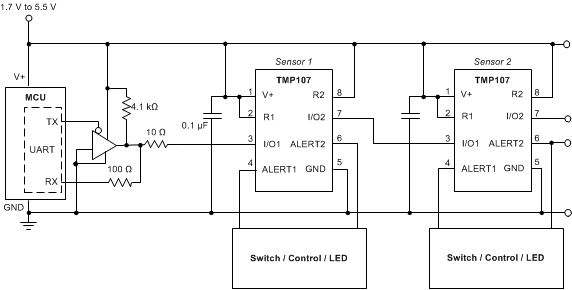SBOS716D May 2015 – January 2020 TMP107
PRODUCTION DATA.
- 1 Features
- 2 Applications
- 3 Description
- 4 Revision History
- 5 Pin Configuration and Functions
- 6 Specifications
-
7 Detailed Description
- 7.1 Overview
- 7.2 Functional Block Diagram
- 7.3 Feature Description
- 7.4 Device Functional Modes
- 7.5 Programming
- 7.6
Register Map
- 7.6.1 Temperature Register (address = 0h) [reset = 0h]
- 7.6.2 Configuration Register (address = 1h) [reset = A000h]
- 7.6.3 High Limit 1 Register (address = 2h) [reset = 7FFCh]
- 7.6.4 Low Limit 1 Register (address = 3h) [reset = 8000h]
- 7.6.5 High Limit 2 Register (address = 4h) [reset = 7FFCh]
- 7.6.6 Low Limit 2 Register (address = 5h) [reset = 8000h]
- 7.6.7 EEPROM n Register (where n = 1 to 8) (addresses = 6h to Dh) [reset = 0h]
- 7.6.8 Die ID Register (address = Fh) [reset = 1107h]
- 8 Application and Implementation
- 9 Power Supply Recommendations
- 10Layout
- 11Device and Documentation Support
- 12Mechanical, Packaging, and Orderable Information
Package Options
Mechanical Data (Package|Pins)
- D|8
Thermal pad, mechanical data (Package|Pins)
Orderable Information
8.2.3 ALERT1 and ALERT2 Pins Used as General-Purpose Output (GPO)
The TMP107 alert pins are also used as a GPO to control external switches or LEDs. This feature is useful in applications wherein the wiring between general-purpose output lines from the microcontroller or host to a control switch or LED can be eliminated by communicating through the I/O pins of TMP107. To configure the ALERTx pins as a GPO, program the high-limit register to the highest temperature (7FFCh) and the low-limit register to the lowest temperature (8000h). This programming disables the ALERTx pins from performing high- and low-limit temperature controls. The configuration register polarity bits (POL1 and POL2) are used to toggle the ALERTx pin output. The ALERTx pins are open-drain outputs; therefore, make sure the R1 and R2 pins are connected to the supply voltage, as shown in Figure 43.
 Figure 43. ALERT1 and ALERT2 Pins Used as General-Purpose Output
Figure 43. ALERT1 and ALERT2 Pins Used as General-Purpose Output